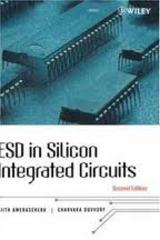
ESD in Silicon Integrated Circuits
A. Amerasekera and C. Duvvury
(1995) xiv + 209 pages
This book provides an understanding of the basic features related to ESD and deals with topics ranging from the physics of devices operating under ESD conditions to approaches for solving and improving ESD performance in advanced ICs. Topics include: Reproduction of ESD-type events in the lab, analysis of semiconductor devices, detailed study of design and layout, case studies of ESD problem solving. This practical guide is written from an industrial perspective and will appeal to engineers and scientists working in the field of IC and transistor design, as well as researchers and advanced students in the fields of device/circuit modeling and semiconductor reliability.
Introduction:@ Background:The ESD Problem:Protecting against ESD:Outline of the Book:References:ESD Phenomena and Test Methods:@ Introduction:Human Body Model (HBM):Machine Model (MM):Charged Device Model (CDM):Comparisons between the Test Methods:Transmission Line Test Method:Other Test Methods:Failure Criteria:Test Procedures:References:Physics and Operation of ESD Protection Circuit Elements@ Introduction:Resistors: Diodes: Forward bias:Reverse bias:p-i-n Diode:@: Transistor Operation: Bipolar transistors:MOS transistors:Avalanche conditions:@: Transistor Operation under ESD Conditions: Bipolar transistors:MOS transistors:@:SCR Operation:References:Design and Layout Requirements@ Introduction: Design Concepts: Thick field device:nMOS transistors (FPDs):Gate-coupled nMOS (GCNMOS):SCR protection devices:@: ESD Protection Design Synthesis: SCR primary protection:Secondary protection devices Field plate diode Isolation resistor:Protection scheme:@: Total Input Protection: Inputs with diffusion resistor:Inputs with polysilicon resistor:Polysilicon resistor reliability:@:Input/Output Buffer Layout and Protection:Selecting a Protection Circuit: Bipolar and BiCMOS Protection Circuits: Introduction:Protection circuit strategies:Bipolar/BiCMOS output protection:Bipolar/BiCMOS input protection:Layout:ESD and performance trade-offs:@:Summary:References:Failure Modes, Reliability Issues and Case Studies:@ Introduction: Failure Mode Analysis: Failure analysis techniques:Electrical characteristics after damage:Physical analysis of failure modes:@:Reliability and Performance Considerations:Advanced CMOS Input Protection:Optimizing the Input Protection Scheme:Designs for Special Applications:Process Effects on Input Protection Design:Total IC Chip Protection:Power Bus Protection: Internal Chip ESD Damage: Vdd Vss Stress current damage:Output to Vdd stress:@:Stress Dependent ESD Behavior:Summary:References:Modeling and Characterization:@ Introduction:The Physics of ESD Damage:Thermal (Second) Breakdown:Analytical Models Using the Heat Equation:Electrothermal Simulations:Circuit Simulations:References:Influence of Processing on ESD:@ Introduction:Source/Drain Junction Effects:Gate Oxides:Contacts and Silicidation: Wells, Epitaxial Thickness and Substrate Resistance: Wells:Epitaxial thickness:Substrate resistance:@:Silicon-On-Insulator (SOl):Packaging:References:Conclusions@ Long-term Relevance of ESD in ICs:State-of-the-Art for ESD Protection:Current Limitations:Future Issues:References:
Contact us at info@electrostatic.com
https://www.electrostatic.com/ (jmc 2023-11-02) © 2023
 Electrostatic Applications
Electrostatic Applications